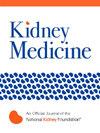Variation in Management of CKD-Associated Pruritus: Results From a Multinational Survey of Kidney Units
IF 3.4
Q1 UROLOGY & NEPHROLOGY
引用次数: 0
Abstract
Rationale & Objective
Chronic kidney disease-associated pruritus (CKDaP) is a distressing symptom affecting a significant proportion of people with advanced kidney disease. There are many studies of varying quality in the literature testing a wide variety of CKDaP therapies and no evidence-based consensus guidelines for management. We aimed to describe the breadth of treatments in use for CKDaP in real-world practice.
Study Design
A cross-sectional online survey.
Setting & Participants
Kidney care units in Australia, New Zealand (NZ), and the United Kingdom (UK). Surveyed from April 2022, to December 2022.
Outcomes
Usage of 28 CKDaP therapies (excluding emollients/moisturizers) was categorized as “first-line,” “second-line,” “refractory symptoms only,” “rarely used,” or “never used.”
Analytical Approach
Descriptive analysis with differences between categories assessed by Fisher exact test.
Results
One hundred four responses were received from 171 contacted kidney units (Australia 51 [49%], NZ 6 [6%], and UK 47 [45%]) with an overall response rate of 61%. Including "other" responses, 35 treatments were in first-line or second-line use. Gabapentinoids (gabapentin or pregabalin) were the most widely used first-line systemic agent (49 units [47%]), followed by antihistamines (27 [26%]). Menthol was the predominant first-line topical agent (41, [39%]). Significant inter-country disparities were noted: doxepin, evening primrose oil, sertraline, and topical γ-linolenic acid were more frequently used in Australia than in NZ, and the UK, whereas hydroxyzine was preferentially used in UK units (P < 0.05). Units with a kidney supportive care service were more likely to use gabapentinoids, 5-hydroxytryptamine3 receptor antagonists, hydroxyzine, and topical therapies, and less likely to use promethazine (P < 0.05).
Limitations
Difelikefalin was not widely available during the survey period, which may limit generalizability.
Conclusions
There is considerable variation in the management of CKDaP. Unexplained clinical variation suggests a need for the development of evidence-based guidelines and additional high-quality studies to inform care.
Plain-Language Summary
People with chronic kidney disease often experience severe itching, which can significantly affect their well-being. There's no clear consensus on the best approach. This study surveyed 104 kidney care units in Australia, New Zealand, and the United Kingdom to understand how they treat this condition in practice. More than 35 different treatments were in use as first-line or second-line therapies with wide variation in treatment approaches both between units and countries. The 3 most commonly used first-line therapies were gabapentinoids, antihistamines, and topical menthol, and no therapy was first-line at a majority of units. This variation in practice suggests a need for better evidence and guidelines to ensure all patients receive the most effective care for pruritus.
ckd相关瘙痒的管理差异:来自肾脏单位的多国调查结果
基本原理及目的慢性肾脏疾病相关性瘙痒症(CKDaP)是影响相当一部分晚期肾脏疾病患者的令人痛苦的症状。文献中有许多质量参差不齐的研究,测试了各种各样的CKDaP治疗方法,但没有基于证据的共识管理指南。我们的目的是描述在现实世界中使用的治疗CKDaP的广度。研究设计:横断面在线调查。设置,参与者:澳大利亚、新西兰(NZ)和英国(UK)的肾病护理单位。调查时间为2022年4月至2022年12月。28种CKDaP疗法(不包括润肤剂/保湿剂)的使用情况被分类为“一线”、“二线”、“仅难治性症状”、“很少使用”或“从未使用”。分析方法:采用Fisher精确检验对类别间差异进行描述性分析。结果171个接触肾单位共收到104份应答(澳大利亚51份[49%],新西兰6份[6%],英国47份[45%]),总应答率为61%。包括“其他”反应在内,35种治疗是一线或二线治疗。加巴喷丁类药物(加巴喷丁或普瑞巴林)是使用最广泛的一线全身药物(49个单位[47%]),其次是抗组胺药(27个单位[26%])。薄荷醇是主要的一线外用药物(41,[39%])。国家间存在显著差异:澳大利亚比新西兰和英国更常使用多虑平、月见草油、舍曲林和外用γ-亚麻酸,而英国单位则优先使用羟嗪(P <;0.05)。有肾脏支持护理服务的单位更有可能使用加巴喷丁类药物、5-羟色胺3受体拮抗剂、羟嗪和局部治疗,而使用异丙嗪的可能性较小(P <;0.05)。在调查期间,异蝇虫素没有广泛使用,这可能限制了普遍性。结论CKDaP的治疗存在较大差异。无法解释的临床变异提示需要制定循证指南和额外的高质量研究来为护理提供信息。患有慢性肾脏疾病的人经常会经历严重的瘙痒,这可能会严重影响他们的健康。对于最好的方法没有明确的共识。这项研究调查了澳大利亚、新西兰和英国的104家肾脏护理单位,以了解他们在实践中如何治疗这种疾病。超过35种不同的治疗方法被用作一线或二线治疗,各单位和国家之间的治疗方法差异很大。最常用的3种一线治疗是加巴喷丁类药物、抗组胺药和局部薄荷醇,大多数单位没有一线治疗。实践中的这种差异表明需要更好的证据和指南,以确保所有患者获得最有效的瘙痒治疗。
本文章由计算机程序翻译,如有差异,请以英文原文为准。
求助全文
约1分钟内获得全文
求助全文

 求助内容:
求助内容: 应助结果提醒方式:
应助结果提醒方式:


